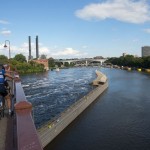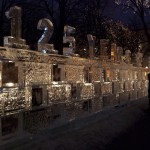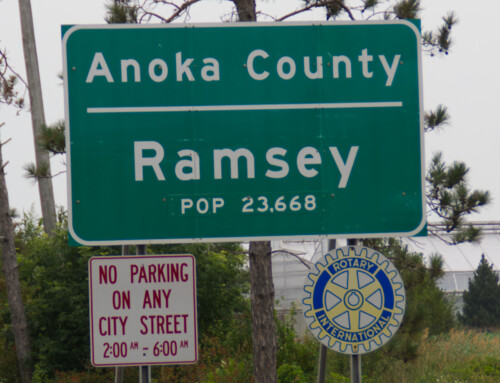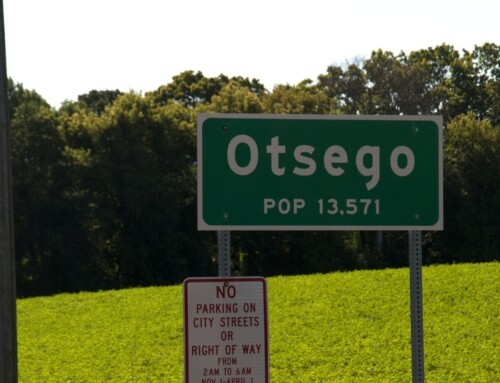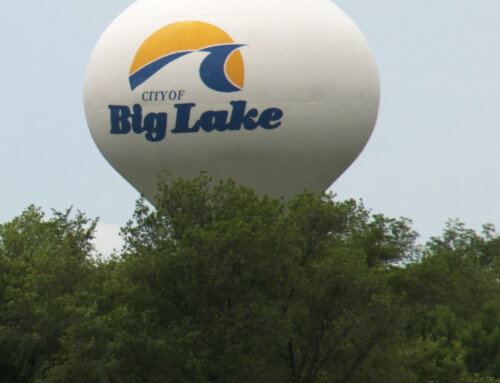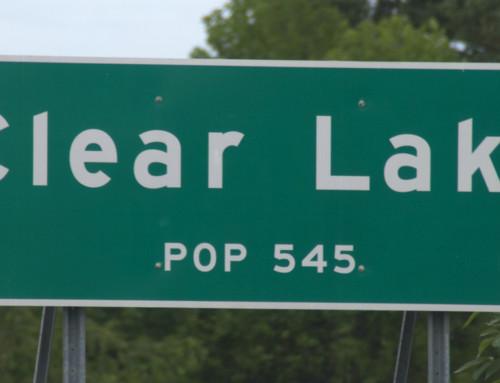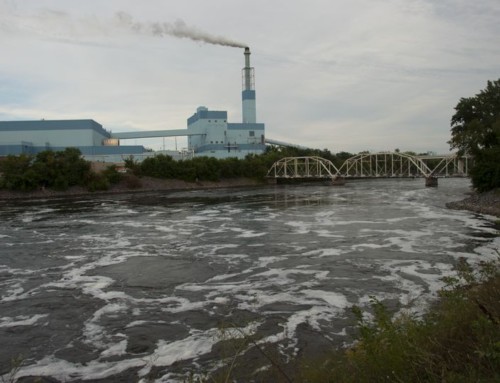Introduction
St. Paul and Minneapolis—the Twin Cities—form the center of a dynamic metropolitan area of some 3.5 million outdoor-loving, cold-tolerant people. In spite of what the nickname implies, the two cities are more like fraternal twins, nurtured by the same mother–the Mississippi River–but growing independently. St. Paul is the quiet, responsible older sister, while Minneapolis is the rowdy and cocky younger brother. William McGivern, the one-time news director for KSTP-TV said: “Minneapolis is banking, country-club sophistication, and pecking order; St. Paul is transportation, family gatherings, friendly squareness, and almost aggressive egalitarianism.”
In spite of their different dispositions, the residents of both cities share a love for active living and good food, and both cities are in the midst of cleaning up and bringing new life to the Mississippi River corridor.
And without that river, there would not be a Twin Cities. While the river was one of the major reasons that this region developed at all, it didn’t play the same role for each place. St. Paul developed as the end of the line for steamboats that traveled the Mississippi. North of St. Anthony Falls, cities like Anoka got started because the Mississippi provided a water route that connected it to the northern fur trade and logging industries. For Minneapolis, though, the Mississippi served a dual role, a route to move all that cut timber from the forests but, more importantly, a source of power, thanks to those falls, to turn that timber into wood products.
Most of what you’ll want to see is in or near the two downtown areas. Away from the historic centers, the Twin Cities sprawl outward to a series of suburbs and exurbs, most of which will have few attractions for visitors, unless you’re going to visit your uncle and aunt.
This is not a comprehensive guide to the Twin Cities. As much as I wish I had the opportunity to explore the entire Twin Cities metro area and tell you all about every hidden gem, that’s just not the way it works for me. I’m all about the Mississippi River and the places that border it. My Twin Cities pages (see below) will help guide you along the Mississippi River corridor. They are meant to help you explore the river’s past and continuing influence on the area.
While the two downtowns are famous for the walkways that allow you to walk from building to building without having to go outside, this is a region where people love to spend time outdoors, regardless of the season. If you visit in winter, which you should, you will find nearly as much happening outdoors as during the summer months, just with more heavily clothed people.
In this section, you will find an overview of the region, with information about getting around, regional attractions, festivals, and sources to help you go deeper. So what are you waiting for?
TIP: You can tell it’s spring in Minnesota when the potholes bloom.
The Communities
The Twin Cities guide includes this page and individual pages for each city on the river.
Northwest Suburbs
The Mississippi River enters the Twin Cities from the northwest, tying together six old communities that have been swallowed up by expansive suburbanization. The Mississippi River played a key role in the founding of many of these communities, because it was one of the primary routes through which cut timber was moved. Sawmills went up that needed workers and stores opened to supply them with food and other goods. Many of these communities today are overwhelmingly residential and therefore won’t have as many attractions for visitors, although there are several lovely public parks along the Mississippi River.
Minneapolis
St. Paul
Southeast Suburbs
If I was writing about the history of the region in the order of importance, I should have rightly started with the area just downriver of Minneapolis and upriver from St. Paul. For the Dakota Indians who lived in this area for centuries, this is the place where life began, at the meeting of the Minnesota and Mississippi Rivers. The area that we now know as the Twin Cities began here—the first Europeans settled at Fort Snelling and Mendota. Visitors today will find a number of attractions around here, as well as further southeast, including many spots where they can access an urban Mississippi River that is surprisingly wild in places.
Places on the West Bank
Highlights
It’s almost unfair to single out a few places when there’s much to enjoy in the Twin Cities, but there are a few experiences that stand above the rest:
- Bicycling along the Mississippi River (see below)
- Mississippi Gateway Regional Park (Brooklyn Park)
- Coon Rapids Dam Regional Park (Coon Rapids)
- Canoeing or kayaking on the Mississippi River (see the Minneapolis page)
- Stone Arch Bridge and St. Anthony Falls (Minneapolis)
- Minnehaha Falls (Minneapolis)
- Mill City Museum (Minneapolis)
- Minnesota Science Center (St. Paul)
- Minnesota History Center (St. Paul)
- James Hill House (St. Paul)
- Fort Snelling, including Fort Snelling State Park
- Sibley House Historic Site (Mendota)
Route Overview
The Twin Cities profiles cover territory from Anoka/Champlin to the suburbs in the southeast near Hastings. If you want to follow the Great River Road precisely through the Twin Cities, the navigation gets a little tricky at times. Here’s one option:
On the East Bank from Champlin to Hastings
- From the US 169 Ferry Street Bridge at Champlin, follow West River Road
- Go south on Minnesota 252 (in Brooklyn Center)
- Go east on I-94
- Exit at W. Broadway Avenue and go east
- South on W. River Road (becomes W. River Parkway)
- West on Godfrey Parkway
- South on Minnesota 55 (Hiawatha Ave.)
- East on Sibley Memorial Highway (Highway 13)
- North/east on Lilydale Road (Highway 45); becomes W. Water St. (Highway 40)
- East on Plato Blvd
- South on Wabasha St. South (becomes Cesar Chavez St., then becomes Concord St)
- South on US 52
- East on Hwy 55 (Courthouse Blvd)
- East on Mississippi Trail (Hwy 42), becomes Nininger Rd, then 2nd St. West
- North on US 61 in Hastings to cross the river and start heading back
On the West Bank from Anoka to Hastings
- North on US 61
- West on Warner Road (becomes Shepard Rd.)
- North on South Mississippi River Blvd., which becomes East River Parkway
- North on 14th Ave SE
- West on SE 4th St.
- South on SE 6th Ave
- North/west on SE Main St., continuing on Marshall St. NE (which then becomes East River Rd.)
- North/west on Coon Rapids Blvd NW
- South on Ibis St. NW
- West on Mississippi Blvd NW
- North/west on Coon Rapids Blvd NW (becomes East River Rd., then S. 5th Ave in Anoka)
- West on E. Main to get back to US 169
River Crossings
There are plenty of places to cross the Mississippi throughout the Twin Cities metro region. From Anoka/Champlin to Hastings, you can cross the river at these places:
In the Northwest Metro Region
- Ferry Street Bridge connects Champlin and Anoka via US Highway 169.
- The Richard P. Braun Bridge connects Brooklyn Park and Coon Rapids via Minnesota Highway 610.
- The I-694 Bridge that connects Brooklyn Center and Fridley.
In Minneapolis
- The Camden Bridge connecting 42nd Ave North and /37th Ave NE
- The Lowry Avenue Bridge
- The Broadway Avenue Bridge
- The Plymouth Avenue Bridge
- The Father Louis Hennepin Bridge for Hennepin Avenue
- The Third Avenue Bridge (Minnesota Highway 65)
- The Stone Arch Bridge (pedestrians and bicycles only)
- The Saint Anthony Falls Bridge for I-35W
- The 10th Avenue Bridge
- Washington Avenue Bridge (Minnesota Highway 122)
- The Dartmouth Bridge for I-94
- F.W. Cappelen Memorial Bridge for Franklin Avenue
Between Minneapolis and St. Paul
- The Lake Street Bridge (aka Marshall Ave Bridge) connecting Lake Street in Minneapolis with Marshall Avenue in St. Paul
- Intercity Bridge (aka Ford Parkway Bridge) connecting 46th Street in Minneapolis with the Ford Parkway in St. Paul
- The Fort Road Bridge connecting St. Paul with Fort Snelling on Minnesota Highway 5
- The Lexington Bridge connecting St. Paul and Lilydale via I35E
In St. Paul
- The Smith Avenue High Bridge (Minnesota Highway 149)
- The Wabasha Street Bridge
- The Robert Street Bridge
- The Lafayette Bridge for US Highway 52
In the Southeast Metro Region
- The Wakota Bridge connecting South St. Paul and Newport via I-494
- The Hastings High Bridge for US Highway 61.
**The Twin Cities Region is covered in Road Tripping Along the Great River Road, Vol. 1. Click the link above for more. Disclosure: This website may be compensated for linking to other sites or for sales of products we link to.
Visitor Information
Each city operates its own tourist information centers. The Minneapolis Convention and Visitors Bureau has a downtown office (250 Marquette Ave. S). Visit St. Paul is located in the Landmark Center in downtown (75 W. 5th St.).
Festivals
I’m sure you could find a festival to your liking just about any weekend in the Twin Cities, especially in the warmer months. Here’s a few that either involve the Mississippi River in a prominent way or that are just very fun.
- The St. Paul Winter Carnival has been part of life in the region almost every year since 1886. You may think it odd to stand outside on a downtown street in St. Paul in January to watch a parade, but I thought it was exhilarating. If that doesn’t appeal to you, you can always grab a viewing spot from one of the skywalks, or just check out the ice and snow sculptures or one of the myriad concerts and special events over the two weekends.
- In the Heart of the Beast Theatre celebrates May Day each year with a fun parade of lots of puppets and masks and spirit.
- In mid-June Minneapolis celebrates art and music along the riverfront with the Stone Arch Bridge Festival.
- In July, Minneapolis celebrates its watery roots with the Minneapolis Aquatennial; there are events around the city, with many along the riverfront.
- The Monarch Festival/Festival de Monarca celebrates the Minnesota to Mexico migration path for the well-traveled butterflies, with music, food, and art at the Lake Nokomis Naturescape (early September).
- St. Paul celebrates its ethnic diversity with the Festival of Nations at downtown’s RiverCentre (early May).
- St. Paul hosts the Irish Fair of Minnesota on Harriet Island in early August.
- The Minnesota Renaissance Festival (3 miles south of Shakopee on Highway 169; 952.445.7361) is one of the largest celebrations of medieval culture in the US; enjoy it weekends from mid-August to late September.
- The Minnesota State Fair is arguably the major social event of the season (late August), a granddaddy of an event that is part country fair (complete with livestock judging), part amusement park (with a busy Midway), part gustatory challenge (think deep-fried bacon or hotdish on a stick), and part music festival (much of it included in the standard admission price).
Regional Attractions
You may want to wander away from the river while you’re visiting the Twin Cities. If you do, here are a few of the regions’s major attractions:
- Valleyfair Amusement Park (Shakopee; 952.445.6500)
- Minnesota Zoo (Apple Valley: 13000 Zoo Boulevard; 952.431.9200);
- The Mall of America (Bloomington: 60 East Broadway) draws millions of tourists every year who come from near and far to shop at the 500+ stores, ride an indoor roller coaster, or visit the aquarium, among other things. I see a mall, but apparently the rest of y’all see something entirely different.
Sports and Recreation
Looking to watch someone else in action? The Twin Cities have plenty of professional sporting teams to follow:
- Minnesota Vikings (Minneapolis: US Bank Stadium; 612.338.4537); National Football League
- Minnesota Twins (Minneapolis: Target Field; 800.33-twins); Major League Baseball
- Minnesota Timberwolves (Minneapolis: Target Center; 800.982.2787); National Basketball Association
- Minnesota Wild (St. Paul: (St. Paul: Xcel Energy Center; 651.265.4800); National Hockey League
- Minnesota Lynx (Minneapolis: Target Center; 612.673.1600); Women’s National Basketball Association
- Minnesota Roller Derby (St. Paul: Wilkins Auditorium, 175 Kellogg Blvd; 612.296.4743)
- Saint Paul Saints (St. Paul: Midway Stadium; 1771 Energy Park Dr.; 651.644.6659) is a member of the American Association of Independent Professional Baseball.
If you’d rather be active rather than actively watching, head to Buck Hill (Burnsville; 15400 Buck Hill Rd.; 952.435.7174) for downhill skiing, snowboarding, and snow tubing.
Arriving
By Air
Minneapolis-St. Paul International Airport is located south of downtown Minneapolis in the suburb of Bloomington. The airport is connected to downtown via the METRO Blue Line light rail service; you can ride the light rail between terminals 1 and 2 for free. It’s an airport with the usual amenities, like taxis, car rental services, domestic and international departures/arrivals, crappy food, and overzealous security.
By Train
The Twin Cities are served by Amtrak’s Empire Builder line that connects Chicago to the Pacific Northwest; the only station for the region is at Saint Paul’s Union Depot (240 Kellogg Blvd.). The next closest stops are St. Cloud to the northwest and Red Wing to the southeast. The station receives one westbound train (leaves at 11:15pm) and one eastbound train each day (leaves at 7:50am daily). If you wanted to take a passenger train along the Mississippi River, by the way, this is your best option. The Empire Builder follows the Mississippi from La Crosse, Wisconsin to St. Cloud, Minnesota.
By Bus
Both Greyhound and Jefferson Lines offer long-distance bus service to the Twin Cities. Both have stations in downtown Minneapolis (950 Hawthorne Ave.) and downtown St. Paul (Union Station), as well as several other spots around the Twin Cities; check their websites for details.
If that’s not enough, Megabus also has service to Minneapolis (the bus stops at a parking lot on the east side of Chicago Ave between S 3rd St and S Washington Ave) and St. Paul (Midway Shopping Center, at the parking lot on the northwest corner of Pascal St N and St. Anthony Ave). You must buy tickets in advance through their website.
By Car
There are many major highways that connect to the Twin Cities. If you have trouble finding one, ask Siri. The main highway that connects the downtown areas is Interstate 94. If it’s not rush hour, you can get from downtown to downtown in about 15 minutes; otherwise, well, queue up Prince on your favorite music device, and you won’t care how long it takes (it will take a while). In spite of all the limited access highways around the Twin Cities, roads are frequently busy and getting from one place to another will probably take longer than you think. Give yourself extra time.
Getting Around
You’ll probably end up using your car to explore the Twin Cities. If you’re like me and tend to use the river as a guidepost for navigating, keep in mind that the Mississippi bends its way through the Twin Cities and often doesn’t follow a north-south direction. This can make some things confusing, like the fact that St. Paul’s west bank is actually south of downtown.
If you want to ditch your car, the Twin Cities has an expanding light rail system and decent bus routes, but the truly exceptional feature is the miles and miles of bicycle paths.
Bicycle Routes
The Twin Cities have hundreds of miles of bike lanes and dedicated bicycle/pedestrian paths, many of them along both sides of the Mississippi River. Minneapolis and St. Paul have both received awards for being among the most bicycle-friendly cities in the US, so don’t be surprised when you see many devoted bicyclists doggedly continue to ride through the brutal winter months.
You don’t even need to bring a bicycle with you. From spring through fall (July 3-5—just kidding! It’s actually April through November), you can rent a bicycle cheaply from one of the 170 Nice Ride stations strategically positioned around the area. Here’s how it works:
Each station has a vending machine that accepts credit cards. You pay a daily fee (or you can pay for an annual membership, if you wish) and then you’ll get a code to unlock a bike. Pick a bike, enter the code, and you’re off. (Note: You won’t find any helmets at the stations. You don’t have to wear one, but if you prefer to do so, you should bring your own.) Now here’s the great part. You can ride the rest of the day without paying another penny, as long as you limit each segment to 30 minutes or less. Each ride under 30 minutes is free, and there’s no limit on the number of times you can turn in a bike and get another one. All you need to do is know where the stations are, so when you get near the 30 minute mark you can return the bike you’re on and get another one. You don’t have to do it his way, of course, but the rental price increases sharply the longer you keep one bike . This might seem an odd pricing system, but it’s meant to ensure that bicycles stay in circulation throughout the day.
In downtown, you can even hire a bicycle taxi (pedicabs) to take you around. Similar to rickshaws, the pedicabs are plentiful in the downtown area, especially in the evening and into the early morning hours, a fun and easy way to get back to where you’re staying after a night of exploring the clubs. There are no set fares; it’s up to you to negotiate a rate with your driver.
Rail
The Metro Transit’s Blue Line (formerly the Hiawatha Line) offers light rail service from the Mall of America to downtown Minneapolis (Target Field Station), with stops at the airport and Fort Snelling. The Green Line connects downtown St. Paul (beginning at Union Station) with the Metrodome Station in downtown Minneapolis, with stops that include the University of Minnesota.
The Northstar Line commuter rail (612.373.3333) runs trains from downtown Minneapolis (Target Field Station) with stops at several Mississippi River towns (Elk River, Anoka, Coon Rapids, and Fridley); riding the entire distance takes about 50 minutes.
Local Bus
Metro Transit operates local bus services for the metropolitan area. One-way fares run from $1.75 to $3.00, depending upon the time of day (rush hour fares are higher) and whether it is regular or express bus. Schedules are available on their website. You can also buy passes for a week, a month, or for multiple rides at discounted rates.
Downtown Skyways
You can explore much of downtown Minneapolis or St. Paul without ever having to go outside, something that you might appreciate more in January than July. Most of the downtown buildings and parking garages are connected via skyways. It’s easy to get lost, but there are plenty of maps, and you can always ask someone for directions.
Dining Tips
Goodness, there is some darn good food in the Twin Cities. Most of the restaurants in my Twin Cities pages will be in the neighborhoods near the Mississippi River. If you want to venture beyond that corridor, check out Mpls.St.Paul Magazine and its comprehensive coverage of the Twin Cities food scene. As always, read user-generated reviews with a healthy dose of skepticism.
The Twin Cities have their fair share of foods that come with a heavily local slant. One of the more famous concoctions is the juicy lucy, a hamburger stuffed with cheese. They’ve been serving them here for decades, while the rest of us are Johnny-come-latelies. Jess Fleming, food writer for the St. Paul Pioneer Press, recommends Matt’s Bar for a taste of the original (with American cheese) or the Blue Door Pub if you’re more adventurous (they have many cheese options, including blue cheese); you’ll see it on many menus, though. A few other foods you might come across, if you’re lucky:
Hotdish, which is baked in a casserole, and usually included a meat like ground beer, liquid like cream of something soup and a crispy topping, preferably tator tots; you’re more likely to eat it at potluck than a restaurant, but you will see it on some menus.
Bars, which are deep-dish sweets that can be as simple as chocolate chip or complex layers of flavors. They are also more common at pot lucks than on restaurant menus.
Swedish dishes like lefse, which are thin potato pancakes that are usually sweet but can be savory, and Swedish meatballs. You can find varities of both at one of the locations of the Taste of Scandinavia Cafe.
Minneapolis and Saint Paul also have large Vietnamese communities, which translates into a wealth of good Vietnamese restaurants.
And let’s name the elephant in the room: SPAM. It’s a Minnesota invention and still produced at a plant about two hours south of the Twin Cities (in Austin, Minnesota). It’s really versatile (just ask Monty Python!) but it’s not for everyone (like vegetarians and vegans). I think it’s rather salty, but many Chinese apparently call it “Meaty Juicy Satisfaction,” according to the folks at the SPAM Museum. You may see it show up on a few menus; if so, go for it! If you don’t like it, you can always go back to the juicy lucy.
Folks in the Twin Cities also support a robust craft brewing industry. The Ultimate Guide to All the Breweries in Minneapolis and St. Paul lists them all and even places them on a map for you.
Lodging Tips
I don’t generally include listings for chain hotels; you can find your favorite brand without my help. I put my time into finding independently-owned lodging options, like bed-and-breakfasts or small motels/hotels. If you don’t see anything you like on these pages, try a service like airbnb to rent a room, a house, or an apartment.
© Dean Klinkenberg, 2013,2018
Community-supported writing
If you like the content at the Mississippi Valley Traveler, please consider showing your support by making a one-time contribution or by subscribing through Patreon. Book sales don’t fully cover my costs, and I don’t have deep corporate pockets bankrolling my work. I’m a freelance writer bringing you stories about life along the Mississippi River. I need your help to keep this going. Every dollar you contribute makes it possible for me to continue sharing stories about America’s Greatest River!
